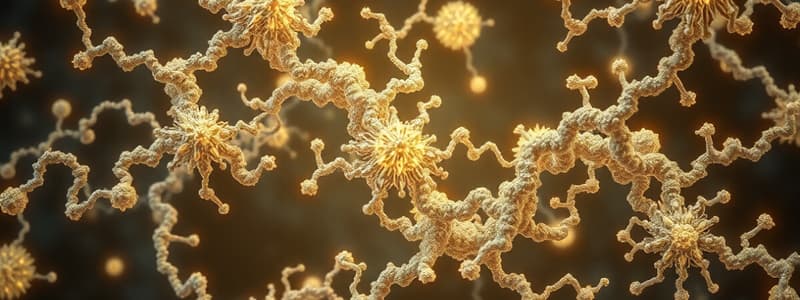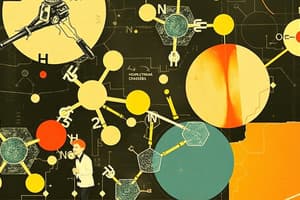Podcast
Questions and Answers
What type of molecules do host components generally include in channel type complexes?
What type of molecules do host components generally include in channel type complexes?
- Tubular channel molecules (correct)
- Cyclic compounds
- Long branched chains
- Monomolecular layers
Which of the following represents a typical guest molecule in channel type complexes?
Which of the following represents a typical guest molecule in channel type complexes?
- Water
- Paraffin (correct)
- Cyclic oligosaccharides
- Glucose
What is a characteristic feature of clathrates?
What is a characteristic feature of clathrates?
- They have a cage-like lattice structure. (correct)
- They involve ionic bonds.
- They are exclusively made of hydrocarbons.
- They contain monomolecular layers.
Which of the following compounds is an example of a clathrate?
Which of the following compounds is an example of a clathrate?
What is the minimum number of glucopyranose units contained in cyclodextrins?
What is the minimum number of glucopyranose units contained in cyclodextrins?
What primarily contributes to the complexation in charge transfer complexes?
What primarily contributes to the complexation in charge transfer complexes?
Which of the following drugs is NOT mentioned as having a nitrogen–carbon–sulfur moiety?
Which of the following drugs is NOT mentioned as having a nitrogen–carbon–sulfur moiety?
Which type of inclusion compound involves a single guest molecule entrapped in one host molecule?
Which type of inclusion compound involves a single guest molecule entrapped in one host molecule?
What type of interactions contribute more to the stability of donor–acceptor complexes?
What type of interactions contribute more to the stability of donor–acceptor complexes?
What do layer type complexes primarily consist of?
What do layer type complexes primarily consist of?
What is the primary result of the complex formed between caffeine and sulfonamide/barbiturate?
What is the primary result of the complex formed between caffeine and sulfonamide/barbiturate?
Which characteristic limits the guest component in channel type complexes?
Which characteristic limits the guest component in channel type complexes?
What is the role of picric acid when forming complexes with weak bases?
What is the role of picric acid when forming complexes with weak bases?
What type of complex is formed when benzoquinone and hydroquinone are combined in equal molar concentrations?
What type of complex is formed when benzoquinone and hydroquinone are combined in equal molar concentrations?
How do molecules containing the N—C==S moiety affect thyroid function in the body?
How do molecules containing the N—C==S moiety affect thyroid function in the body?
What type of forces are utilized to form complexes between caffeine and other drugs?
What type of forces are utilized to form complexes between caffeine and other drugs?
Which of the following additives is known to form complexes that may lead to undesirable effects such as flocculation and delayed absorption?
Which of the following additives is known to form complexes that may lead to undesirable effects such as flocculation and delayed absorption?
What effect does complexation with polyvinylpyrrolidone (PVP) have on Ajmaline?
What effect does complexation with polyvinylpyrrolidone (PVP) have on Ajmaline?
How does caffeine affect the pharmacokinetics of acidic drugs?
How does caffeine affect the pharmacokinetics of acidic drugs?
What is a potential advantage of forming a caffeine-drug complex?
What is a potential advantage of forming a caffeine-drug complex?
Which of the following correctly describes inclusion complexes?
Which of the following correctly describes inclusion complexes?
What is one of the negative outcomes of the complexation between caffeine and benzocaine?
What is one of the negative outcomes of the complexation between caffeine and benzocaine?
What type of forces contribute to the complexation between caffeine and acidic drugs?
What type of forces contribute to the complexation between caffeine and acidic drugs?
What undesirable effect can result from the combination of complexing agents like CMC with drugs?
What undesirable effect can result from the combination of complexing agents like CMC with drugs?
What is the primary reason the interior of cyclodextrin (CD) cavity is hydrophobic?
What is the primary reason the interior of cyclodextrin (CD) cavity is hydrophobic?
Which cyclodextrin has the largest cavity useful for pharmaceutical applications?
Which cyclodextrin has the largest cavity useful for pharmaceutical applications?
How does complexation with cyclodextrin affect the solubility of retinoic acid?
How does complexation with cyclodextrin affect the solubility of retinoic acid?
What effect does complexation have on the dissolution of phenobarbitone?
What effect does complexation have on the dissolution of phenobarbitone?
Which drug's stability can be enhanced through complexation with cyclodextrin?
Which drug's stability can be enhanced through complexation with cyclodextrin?
How does complexation affect the absorption of Tetracycline?
How does complexation affect the absorption of Tetracycline?
What is a key benefit of complexation in terms of the physical state of a liquid drug?
What is a key benefit of complexation in terms of the physical state of a liquid drug?
What effect does complexation with Caffeine have on Benzocaine?
What effect does complexation with Caffeine have on Benzocaine?
Flashcards
Organic Molecular Complexes
Organic Molecular Complexes
A group of molecules held together by weak forces, like hydrogen bonds or van der Waals forces, without covalent bonds.
Charge Transfer Complexes
Charge Transfer Complexes
Organic complexes where one molecule polarizes the other, creating ionic interactions or charge transfer.
Nitrogen-Carbon-Sulfur Complexes
Nitrogen-Carbon-Sulfur Complexes
Molecules with a nitrogen-carbon-sulfur (N-C=S) group can bind to iodine atoms.
Caffeine-Drug Complexes
Caffeine-Drug Complexes
Signup and view all the flashcards
Quinhydrone Complex
Quinhydrone Complex
Signup and view all the flashcards
Picric Acid Complexes
Picric Acid Complexes
Signup and view all the flashcards
Butesin Picrate
Butesin Picrate
Signup and view all the flashcards
Donor-Acceptor Complex
Donor-Acceptor Complex
Signup and view all the flashcards
Channel Type Complexation
Channel Type Complexation
Signup and view all the flashcards
Layer Type Complexation
Layer Type Complexation
Signup and view all the flashcards
Clathrate Complex
Clathrate Complex
Signup and view all the flashcards
Monomolecular Inclusion Complex
Monomolecular Inclusion Complex
Signup and view all the flashcards
Cyclodextrins
Cyclodextrins
Signup and view all the flashcards
Separation of Isomers
Separation of Isomers
Signup and view all the flashcards
Bentonite in Complexation
Bentonite in Complexation
Signup and view all the flashcards
Clathrate Stability
Clathrate Stability
Signup and view all the flashcards
Drug-Polymer Complexation
Drug-Polymer Complexation
Signup and view all the flashcards
Caffeine-Drug Complexation
Caffeine-Drug Complexation
Signup and view all the flashcards
Benefits of Caffeine Complexation
Benefits of Caffeine Complexation
Signup and view all the flashcards
Caffeine Complexation with Local Anesthetics
Caffeine Complexation with Local Anesthetics
Signup and view all the flashcards
Caffeine-Gentisic Acid Complex
Caffeine-Gentisic Acid Complex
Signup and view all the flashcards
Inclusion complexes
Inclusion complexes
Signup and view all the flashcards
Another name for inclusion complexes
Another name for inclusion complexes
Signup and view all the flashcards
Key difference of Inclusion Complexes
Key difference of Inclusion Complexes
Signup and view all the flashcards
What are Cyclodextrins?
What are Cyclodextrins?
Signup and view all the flashcards
How do CDs interact with other molecules?
How do CDs interact with other molecules?
Signup and view all the flashcards
What are the different types of CDs?
What are the different types of CDs?
Signup and view all the flashcards
How can CDs enhance drug solubility?
How can CDs enhance drug solubility?
Signup and view all the flashcards
How does CD complexation affect dissolution?
How does CD complexation affect dissolution?
Signup and view all the flashcards
How can CDs improve drug stability?
How can CDs improve drug stability?
Signup and view all the flashcards
How does CD complexation impact drug partitioning?
How does CD complexation impact drug partitioning?
Signup and view all the flashcards
How does CD complexation affect drug absorption?
How does CD complexation affect drug absorption?
Signup and view all the flashcards
Study Notes
Complexation and Protein Binding
- Organic molecules are held together by weak forces like hydrogen bonds, van der Waals forces, and donor-acceptor interactions. Covalent bonds are not typically involved.
- Charge transfer complexes result when one molecule polarizes another, creating ionic interactions or charge transfer.
- Donor-acceptor complexes rely more on London dispersion forces and dipole-dipole interactions for stability.
- Many organic complexes are too weak to separate from solutions as distinct compounds.
- Disulfiram, clomethiazole, and tolnaftate possess N-C-S moieties.
- Interactions involving iodine atoms may result from charge transfer, inhibiting thyroid function.
- Caffeine, sulfonamides, and barbiturates form complexes via dipole-dipole forces and hydrogen bonding between polarized carbonyl groups.
- Quinhydrone complexes (benzoquinone and hydroquinone) are used in pH determinations due to the formed complex.
- Picric acid forms complexes, like Butesin picrate, combining antiseptic and anesthetic properties.
- Pharmaceutical additives like polyethylene glycols (PEGs), carboxymethyl cellulose (CMC), and carbowaxes can form complexes with other drugs (e.g., tannic acid, salicylic acid, phenols).
- Interactions can cause negative side effects from incompatibilities, like precipitates, flocculates, or delayed absorption.
- CMC and amphetamine show poor absorption.
- Ajmaline absorption is improved by complexation with polyvinylpyrrolidone (PVP).
- Caffeine complexes with acidic drugs such as sulfonamides and barbiturates.
- Benzocaine, procaine, and tetracaine form complexes with caffeine.
- Caffeine complexation can enhance drug solubility, mask bitter taste, improve stability.
- Caffeine can reduce benzocaine metabolism.
- Benzodiazepine efficacy is reduced by caffeine combination.
- Inclusion complexes (occlusion compounds) trap one component within the crystal lattice of another.
- Channel complexes are formed by crystallization of host molecules, creating channels specific for guest molecules.
- Host molecules are tubular, such as deoxycholic acid, urea, or thiourea.
- Guest molecules are typically long, unbranched compounds.
- Starch-iodine complexes are formed within channels.
- Layer complexes include alternating layers of guest and host molecules, where guest molecules are trapped within the layers.
- Clays, like montmorillonite, can trap hydrocarbons and alcohols in this way.
- The stability of clathrates depends on the structure's strength.
- Warfarin sodium USP is a clathrate example that crystallizes as a white powder.
- Monomolecular inclusion molecules contain one guest molecule trapped in a host molecule's cavity.
- Cyclodextrins are cyclic oligosaccharides, and are produced from starch.
- The interior of CD cavities is hydrophobic (CH2), while the exterior is hydrophilic (OH).
- CD complexation does not involve covalent bonds, but utilizes hydrophobic interactions.
- A-CD, B-CD, and Y-CD complex contain 6, 7, and 8 glucose units; B-CD and Y-CD are generally more beneficial to drug applications due to larger cavities.
- Aqueous solubility is improved by complexation with CD.
CD Complex Applications
- Enhanced solubility: Retinoic acid solubility is significantly increased by complexation with β-CD.
- Enhanced dissolution: Famotidine and Tolbutamide dissolve better when combined with β-CD.
- Enhanced stability: Aspirin, ephedrine, and testosterone experience improved stability when complexed with β-CD.
- Sustained release: Ethylated β-CD is used to manage the release of diltiazem.
Applications of Complexation
- Solubility: Drugs like caffeine enhance solubility of PABA.
- Dissolution: β-cyclodextrin improves Phenobarbital dissolution.
- Physical State: β-cyclodextrin converts liquid nitroglycerin into a solid complex.
- Stability: β-cyclodextrin provides stability to Vitamin A and D.
Chemical and Other Considerations
- Chemical stability: Complexation may inhibit undesirable chemical reactions, such as the hydrolysis of benzocaine.
- Partition coefficient: Complexation improves the partition coefficient of drugs like permanganate.
- Absorption and bioavailability: Complexing with cations like calcium or magnesium reduces absorption of some drugs (like tetracyclines).
- Reduced toxicity: Complexation of certain drugs (indomethacin and barbiturates) with β-cyclodextrin to reduce ulcerogenicity.
- Drug activity: 8-hydroxy quinoline complexes with iron (Fe) exhibit improved antimalarial activity.
- Anti-tuberculosis activity: Para-amino-salicylic acid complexes with copper (Cu) exhibit improved anti-tuberculosis activity.
- Metal poisoning antidote: Dimercaprol (BAL) and EDTA are used as antidotes for metal poisoning and blood preservation.
- Assay of drugs: Complexometric titrations are employed to analyze drugs containing metal ions.
- Reduced Volatility: Cyclodextrins stabilize volatile drugs, preventing unpleasant odors.
Studying That Suits You
Use AI to generate personalized quizzes and flashcards to suit your learning preferences.




